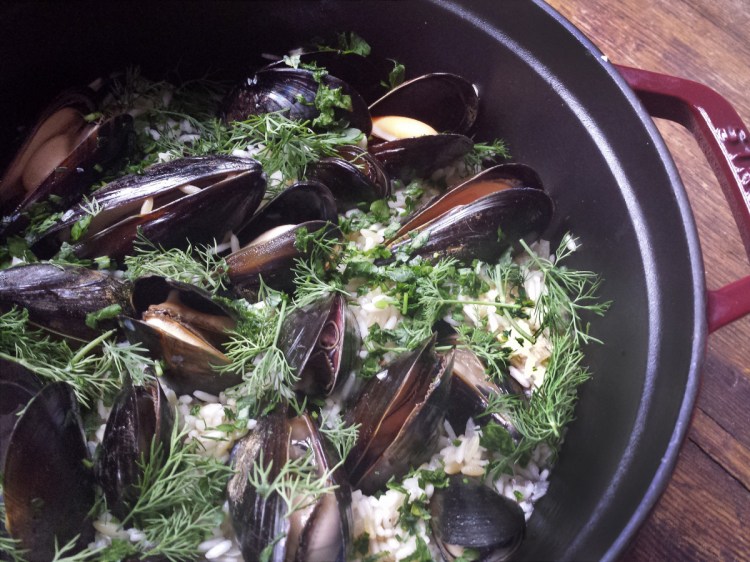Sustainable food production is sometimes viewed solely through a environmental lens. Was this food grown, harvested and prepared in a way that will allow food to be produced on that land or in that water for generations to come? The answer to that question must be yes, as it gets to the root of why we take pains to eat more sustainably in the first place.
But another side of the sustainable food production coin is economic. Can the producers afford to keep generating this food for future markets? It’s one of the three legs of the oft-referenced sustainability stool: 1) Environment 2) Culture and 3) Economic sustainability. Without all three, many say, projects are not sustainable.
Long-term economic viability of any sustainable food enterprise happens in two ways: Existing customers pay more to cover ever-rising production costs or producers expand their market base to tap into the economies of scale.
The latter is poised to happen for Maine’s exploding shellfish aquaculture industry as regional, national and international markets clamor for cold water shellfish. Domestically, demand for oysters will outpace supply through 2026, according to a study prepared by The Hale Group at the direction of the Gulf of Maine Research Institute’s Aquaculture Program. The same study shows the U.S. market for live mussels growing from $68 million this year to $90 million by 2030 and that the domestic supply of scallops in the U.S. meets only half of the domestic demand. While wild scallops stocks in Maine waters have responded well to conservation efforts, wild mussels and oysters stocks are still considered to be very low. An efficient means of meeting worldwide demand to eat them is to farm them.
In May, I attended a TopGun Pitch-Off event in Brunswick where eight Maine shellfish aquaculture companies detailed their plans for tapping into growing domestic and international markets. TopGun is a program run by the Maine Center for Entrepreneurs. Competitively selected entrepreneurs participate in a 4-month program, meeting weekly in locations around the state with fellow Maine professionals and mentors in business development, finance, marketing and sales. Beginning with just a dozen entrepreneurs in Portland in 2009, program organizers say TopGun has to date helped over 200 Maine companies grow. This year marks the first time a TopGun group has focused on aquaculture ventures.
The Pitch-Off is the final exam of sorts for TopGun program participants. Each company gets just five minutes to pitch, as explicitly as possible, how they plan to grow to meet expanding markets. Only two of the eight contenders at the TopGun aquaculture Pitch-Off on May 9 – Matthew Moretti of Bangs Island Mussels and Jonathan Turcotte of Glidden Point Oyster Co. – moved on to the statewide Pitch-Off on May 23 to compete for a $25,000 prize offered by Maine Technology Institute; the prize money is to help them implement their plans. But the trend to push Maine shellfish beyond state lines was clearly evident.
Bangs Island Mussels sought capital to build more floats to meet demand for its rope-grown mussels, which the company sells across the country. Moretti says his company is perpetually sold out of mussels.

Shallots, fennel, orzo and rice await wine and stock to simmer. Mussels are then cooked right on top.
Turcotte explained that Glidden Point would like to increase its capacity to ship its diver-harvested Damariscotta River oysters to more restaurants nationally.
Basket Island Oysters in Casco Bay wants to buy an additional upweller – a floating device used to grow out small oyster seed into spat that are then sold to other local oyster companies looking to feed the country’s growing appetite for Maine oysters.
Robinhood Cove-based Eros Oysters is looking for capital to help push a reliable, year-round supply of oysters from multiple farms in the Georgetown area into supermarkets.
And Damariscotta River Distribution needs marketing resources to push local oysters into international markets, where Maine lobster has already made its mark.
Ultimately, the $25,000 Pitch-Off prize went to Portland-based MyBodyModel, a company that built a web application for fashion-sketching templates that are unique to the user’s body measurements. But prize money aside, the TopGun program and Pitch-Off process made it clear that Maine aquaculture is poised to make its mark far from home. And since these oysters, mussels and scallops act as filters – providing the ecosystem service of cleaning the water as they eat phytoplankton and algae – the more of them at work in Maine waters, the better.
Should you want to help ensure the industry’s economic viability, eat more Maine shellfish more often. Easiest homework assignment ever.
ABOUT THE WRITER
CHRISTINE BURNS RUDALEVIGE is a food writer, recipe developer and tester, and cooking teacher in Brunswick, and the author of “Green Plate Special,” a cookbook from Islandport based on these columns. She can be contacted at cburns1227@gmail.com.
Correction: This story was updated at 10:45 a.m. Monday, June 11, 2018, to correct the oyster company in Casco Bay seeking to purchase an upweller. It is Basket Island Oysters.
Send questions/comments to the editors.



Success. Please wait for the page to reload. If the page does not reload within 5 seconds, please refresh the page.
Enter your email and password to access comments.
Hi, to comment on stories you must . This profile is in addition to your subscription and website login.
Already have a commenting profile? .
Invalid username/password.
Please check your email to confirm and complete your registration.
Only subscribers are eligible to post comments. Please subscribe or login first for digital access. Here’s why.
Use the form below to reset your password. When you've submitted your account email, we will send an email with a reset code.